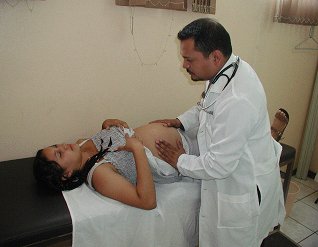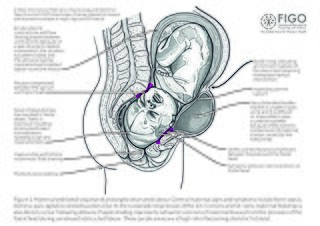Obstetrics is the field of study concentrated on pregnancy, childbirth and the postpartum period. As a medical specialty, obstetrics is combined with gynecology under the discipline known as obstetrics and gynecology (OB/GYN), which is a surgical field.

Childbirth, also known as labour, parturition and delivery, is the completion of pregnancy where one or more babies exits the internal environment of the mother via vaginal delivery or caesarean section. In 2019, there were about 140.11 million human births globally. In the developed countries, most deliveries occur in hospitals, while in the developing countries most are home births.

Prenatal care, also known as antenatal care, is a type of preventive healthcare. It is provided in the form of medical checkups, consisting of recommendations on managing a healthy lifestyle and the provision of medical information such as maternal physiological changes in pregnancy, biological changes, and prenatal nutrition including prenatal vitamins, which prevents potential health problems throughout the course of the pregnancy and promotes the mother and child's health alike. The availability of routine prenatal care, including prenatal screening and diagnosis, has played a part in reducing the frequency of maternal death, miscarriages, birth defects, low birth weight, neonatal infections and other preventable health problems.

A doula is a trained professional who provides expert guidance for the service of others and who supports another person through a significant health-related experience, such as childbirth, miscarriage, induced abortion or stillbirth, as well as non-reproductive experiences such as dying. A doula may also provide support to the client's partner, family, and friends.

Obstetric fistula is a medical condition in which a hole develops in the birth canal as a result of childbirth. This can be between the vagina and rectum, ureter, or bladder. It can result in incontinence of urine or feces. Complications may include depression, infertility, and social isolation.

Maternal death or maternal mortality is defined in slightly different ways by several different health organizations. The World Health Organization (WHO) defines maternal death as the death of a pregnant mother due to complications related to pregnancy, underlying conditions worsened by the pregnancy or management of these conditions. This can occur either while they are pregnant or within six weeks of resolution of the pregnancy. The CDC definition of pregnancy-related deaths extends the period of consideration to include one year from the resolution of the pregnancy. Pregnancy associated death, as defined by the American College of Obstetricians and Gynecologists (ACOG), are all deaths occurring within one year of a pregnancy resolution. Identification of pregnancy associated deaths is important for deciding whether or not the pregnancy was a direct or indirect contributing cause of the death.

A home birth is a birth that takes place in a residence rather than in a hospital or a birthing center. They may be attended by a midwife, or lay attendant with experience in managing home births. Home birth was, until the advent of modern medicine, the de facto method of delivery. The term was coined in the middle of the 19th century as births began to take place in hospitals.

Unassisted childbirth (UC) refers to the process of intentionally giving birth without the assistance of a medical birth attendant. It may also be known as freebirth, DIY (do-it-yourself) birth, unhindered birth, and unassisted home birth. Unassisted childbirth is by definition a planned process, and is thus distinct from unassisted birth due to reasons of emergency, lack of access to a skilled birth attendant, or other. It is also different from homebirth, although most UCs also happen within the home.
Caesarean delivery on maternal request (CDMR) is a caesarean section birth requested by the pregnant woman without a medical reason.
Maternal health is the health of women during pregnancy, childbirth, and the postpartum period. In most cases, maternal health encompasses the health care dimensions of family planning, preconception, prenatal, and postnatal care in order to ensure a positive and fulfilling experience. In other cases, maternal health can reduce maternal morbidity and mortality. Maternal health revolves around the health and wellness of pregnant women, particularly when they are pregnant, at the time they give birth, and during child-raising. WHO has indicated that even though motherhood has been considered as a fulfilling natural experience that is emotional to the mother, a high percentage of women develop health problems and sometimes even die. Because of this, there is a need to invest in the health of women. The investment can be achieved in different ways, among the main ones being subsidizing the healthcare cost, education on maternal health, encouraging effective family planning, and ensuring progressive check up on the health of women with children. Maternal morbidity and mortality particularly affects women of color and women living in low and lower-middle income countries.
A birth attendant, also known as skilled birth attendant, is a health professional who provides basic and emergency care to women and their newborns during pregnancy, childbirth and the postpartum period. A birth attendant, who may be a midwife, physician, obstetrician, or nurse, is trained to be present at ("attend") childbirth, whether the delivery takes place in a health care institution or at home, to recognize and respond appropriately to medical complications, and to implement interventions to help prevent them in the first place, including through prenatal care. Different birth attendants are able to provide different levels of care.

The non-pneumatic anti-shock garment (NASG) is a low-technology first-aid device used to treat hypovolemic shock. Its efficacy for reducing maternal deaths due to obstetrical hemorrhage is being researched. Obstetrical hemorrhage is heavy bleeding of a woman during or shortly after a pregnancy. Current estimates suggest over 300,000 women die from obstetrical hemorrhage every year with 99% of cases occurring in developing countries; many of these deaths are preventable. Many women in resource-poor settings deliver far from health-care facilities. Once hemorrhage has been identified, many women die before reaching or receiving adequate treatment. The NASG can be used to keep women alive until they can get the treatment they need.
A maternal near miss (MNM) is an event in which a pregnant woman comes close to maternal death, but does not die – a "near-miss". Traditionally, the analysis of maternal deaths has been the criterion of choice for evaluating women's health and the quality of obstetric care. Due to the success of modern medicine such deaths have become very rare in developed countries, which has led to an increased interest in analyzing so-called "near miss" events.

Uganda, like many developing countries, has high maternal mortality ratio at 153 per 100,000 live births.According to the World Health Organization (WHO), a maternal death is the death of a woman while pregnant or within 42 days of termination of pregnancy, irrespective of the duration and site of the pregnancy, from any cause related to or aggravated by the pregnancy or its management but not from accidental or incidental causes. In situations where attribution of the cause of death is inadequate, another definition, pregnancy-related death was coined by the US Centers for Disease Control (CDC), defined as the death of a woman while pregnant or within 42 days of termination of pregnancy, irrespective of the cause of death.
Sustainable Development Goals is a post Millennium Development Goal agenda by experts in the world which will be implemented within the next 15 years until 2030. It has seventeen goals and 169 targets as a whole where SDG 3 deal with ensuring health lives and promote well-being for all at all ages. Sustainable Development Goal 3 has nine targets and four sub targets related with different areas of health. One of the targets target 3.1 is a target to achieve a reduction of global maternal mortality ratio to less than 70 per 100,000 live births .Maternal death is defined as "The death of a woman while pregnant or within 42 days of termination of pregnancy, irrespective of the duration and the site of the pregnancy, from any cause related to or aggravated by the pregnancy or its management, but not from accidental or incidental causes.
This article provides a background on Nepal as a whole, with a focus on the nation's childbearing and birthing practices. While modern Western medicine has disseminated across the country to varying degrees, different regions in Nepal continue to practice obstetric and newborn care according to traditional beliefs, attitudes, and customs.
In its early history, Mexico was occupied by a large number of indigenous tribes such as the Mayans and Aztecs. In the 16th century, Spain colonized New Spain and took over the land from the indigenous peoples. Though it is now an independent nation, Mexico retains much of the cultural influence of Spain, including its official religion of Catholicism, the Spanish language, and the importance of machismo - the belief that men are superior to women. Mexico also retains much of the traditional beliefs of the indigenous peoples who first occupied the country. Besides Spanish, there are over one hundred different languages spoken in the country today. As a result, the current medical system involves a mix of traditional and Western medicinal techniques.

No Pain Labor & Delivery – Global Health Initiative is a non-for-profit organization. Founded in 2006, the program focuses on correcting the unnecessarily high caesarean delivery rate and the poor utilization of neuraxial labor analgesia in China.
Midwives in South Africa are nurses who focus on the care of pregnant women and the delivery of babies. Midwives have the ability to work independently in cases of healthy pregnancies and problem-free deliveries; however, they can refer patients to gynaecologists or obstetricians when complications are diagnosed. The majority of pregnant women in South Africa use the public healthcare system, and most of this care is provided by midwives.
The Abiye Programme is a home-grown comprehensive health initiative formulated to tackle the challenges of maternal mortality and morbidity in Ondo State, Nigeria. It was initiated in 2009 by the Mimiko administration in response to the 2008 Nigeria Demographic Health Survey (NDHS) which put Ondo State as having the worst maternal and child health indices in the southwest of Nigeria. The Abiye programme was also intended to achieve the Millennium Development Goals 4 and 5 by 2015. It is a free health program for pregnant women, and young children up to age 5. The Abiye initiative aims at ensuring that maternal health care service delivery in Ondo state is accessible and efficient enough to effect a reduction in the rate of maternal and infant mortality The Abiye model has been recognized by the World Bank as a viable template for achieving the targets of the Millennium Development Goals on maternal health within the African continent Ondo State is the only state in Nigeria that met the MDG indicators of reducing maternal death in the country, surpassing the goal with a 75 percent reduction. By 2016, the Ondo State Government had reduced MMR by 84.9 per cent; from 745 per 100,000 live births in 2009 to 112 per 100,000 live births in 2016 through the Abiye Initiative. The programme is funded by the Ondo State government.










